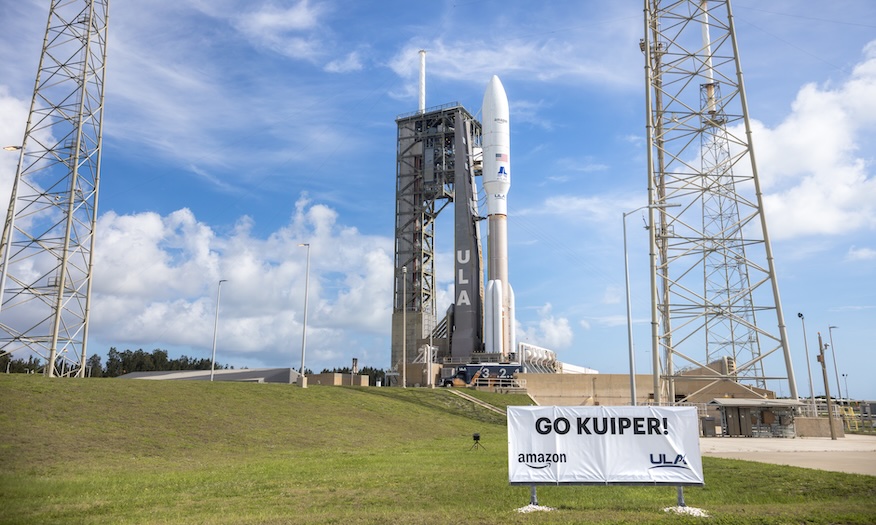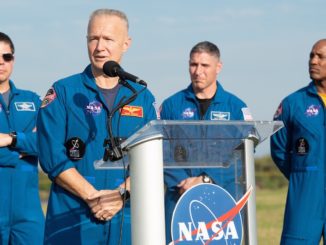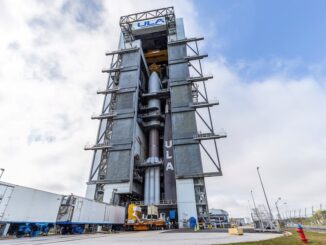
Update Aug. 7, 10:18 a.m. EDT: SpaceX scrubbed the launch attempt; updating weather information.
Update Aug. 8, 12:37 p.m. EDT: SpaceX scrubbed a Friday launch attempt, now targeting Saturday, Aug. 9. Added updated weather info.
Update Aug. 9, 12:06 p.m. EDT: SpaceX scrubbed the launch due to poor weather, now targeting Sunday, Aug. 10; updating weather information.
Amazon is back at the launch pad once again with more of its Project Kuiper broadband internet satellites. The tech giant is getting a lift to space on a SpaceX Falcon 9 rocket set to launch from Cape Canaveral Space Force Station.
However, the launch of the mission, dubbed KF-02, has faced multiple setbacks to adding its next 24 satellites into low Earth orbit. On Saturday, storms pushed on shore across the spaceport, forcing a scrub with just 28 seconds remaining on the clock.
During the first launch attempt on Thursday, SpaceX ended up waiving off their launch attempt prior to the start of fueling and said on social media that it did so to allow time for “additional vehicle checkouts.”
Then, ahead of a launch window on Friday, SpaceX lowered the rocket at the launchpad to do some type of work on the vehicle. The company announced Friday morning that it was moving to a Saturday launch attempt about an hour before it returned its rocket to the vertical launch position.
KF-02, is the second out of three Falcon 9 flights purchased by Amazon for the deployment of its satellite constellation, which will eventually consist of more than 3,200 spacecraft in low Earth orbit.
Liftoff from Space Launch Complex 40 is now scheduled for 8:57 a.m. EDT (1257 UTC) on Sunday, Aug. 10. Spaceflight Now will have live coverage beginning about an hour prior to liftoff.
On Saturday, the 45th Weather Squadron forecast a 45 percent chance for favorable weather for Sunday’s launch attempt, citing concerns for cumulus clouds, anvil clouds and lightning.
“A stationary boundary will remain draped across north-central Florida, maintaining deep atmospheric moisture across the Space Coast,” launch weather officers wrote. “Strengthening southerly flow will help keep early morning convection mainly offshore. However, scattered showers or storms cannot be ruled out.”
As it did with its first launch of Kuiper satellites, SpaceX will be using a brand new Falcon 9 first stage booster. It’s believed to be the booster with the tail number B1091.
In a May 7 post on X, formerly Twitter, Jon Edwards, SpaceX vice president of Falcon and Dragon, said that B1091 will be used as a Falcon 9 booster “a handful of times before being reconfigured and flying as a Falcon Heavy” center booster.
“This way we get some use out of it while the Heavy customer finishes up the payload while also reducing risk as it will be flight proven,” Edwards said. While not explicitly stated, the payload for the Falcon Heavy is likely Astrobotic’s Griffin lander, which is scheduled to launch no earlier than late 2025.
A little more than eight minutes into the flight of the KF-02 mission, B1091 will target a landing on the SpaceX droneship, ‘A Shortfall of Gravitas,’ positioned in the Atlantic Ocean. If successful, this will be the 120th booster landing on this vessel and the 486th booster landing to date.

Ramping up cadence
The KF-02 mission scheduled to launch Aug. 7 is the fourth mission to launch fully operational Project Kuiper satellites for Amazon. The previous missions used two United Launch Alliance Atlas 5 551 rockets and a Falcon 9.
Amazon purchased nine Atlas 5 rockets (one was used for a prototype mission in 2023), three Falcon 9 rockets that Amazon purchased years ago. There are currently 78 Kuiper satellites on orbit, which will become 102 following the KF-02 deployment.
Amazon hasn’t announced when its third and final planned launch on a Falcon 9 will take place.
ULA is preparing to launch the first of two national security missions for the U.S. Space Force beginning with USSF-106 on Aug. 12 and then it will launch its first batch of 45 Kuiper satellites on its Vulcan rocket. A date for that mission, designated KV-01, hasn’t been announced.
In total, Amazon purchased 38 Vulcan launches, which are all expected to launch from Florida’s Space Coast.
Amazon also has dozens of flights booked between Blue Origin, billionaire Jeff Bezos’ other major venture, and Arianespace. However, it remains uncertain as to when those companies may start launching missions for the tech giant.
ULA said its goal is to ramp up to a cadence of two launches per month between its Vulcan and Atlas rockets by the end of 2025, so it could launch as many as 10 more times this year, if all goes to plan.

Those launches will be some combination of Kuiper satellites, national security payloads and potentially Viasat’s ViaSat-3 F2 satellite. Viasat said in its Q1 2026 shareholder letter that the satellite, which is slated to fly on an Atlas 5 rocket, will ship to the Cape by the end of September.
The second launch of Blue Origin’s New Glenn rocket is set to be NASA’s EscaPADE mission to Mars, but it’s not entirely clear when that will launch and what’s next on the manifest.
Arianespace meanwhile is set to fly its third Ariane 6 rocket no earlier than Aug. 12 from Europe’s Spaceport in French Guiana. The company is also trying ramp up its launch cadence, but it’s not planning for more than five launches total in 2025 and its long-term goal is for nine or ten launches annually.



